garden landscape press blogs
Marin Modern - Eichler House Landscape - A Case Study
Posted by Robert Leeper on Wednesday, June 23rd, 2010 at 5:08pm.
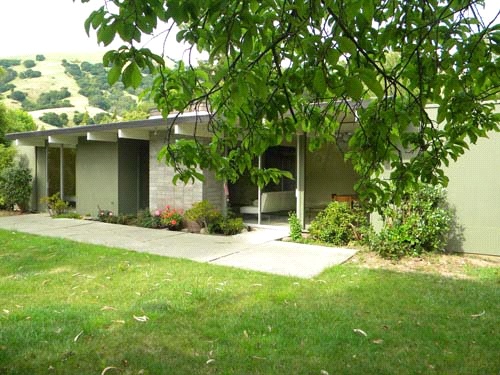
Whenever people ask me, "How do you figure out what to do?", my first response is, "I don't really know, it's mostly intuitive at this point." But the reality is that there is a whole lot of theory, education, travel, exposure, reading and practice that goes into how any designer comes up with ideas of what to do with a property.
From my education - at LSU, in Baton Rouge - we were taught that the design comes from 3 places: first, the style of the home (no sense going against what you have, and also a desire to integrate the architecture and the landscape), second, what the land can actual do (this is what is now called sustainability, meaning what can really grow in a cetain place, not require vast resources, and last a lifetime) and third, what the client's needs and uses are for the outside area (which can be anything from privacy, to a vegetable garden, outdoor entertaining, or a soft-place for the kids to play). I might add a fourth dimension: the aesthetic vision of the designer. This is what people usually see first - the recognizable, individual style of a particular designer - but there is a lot of backstory to even the most expressive design.
All these factors are in play, and these various thoughts are what drives a design. So, in an attempt to pull back the curtain, and walk you through the design process, I'm going to document a design consultation. I will try to show you how I come up with ideas, in this case, for a beautiful mid-century modern Eichler Home in Marin County.
First, there is the architecture. When Marin Modern Real Estate showed me the case study house - and told me it was built by Joseph Eichler - I could barely wait. There are quite a few Eichler style homes in Austin, and I have been fortunate to have seen several. I was excited to learn how many are in Marin, and was really happy to get a chance to do a design for one here.

I will start with the front, which is decent. But once I start looking closely at a project, I start to want to remove things. One thing people are terrified to do is to remove plants. In this case, the original plantings have grown to the point where they are actually crowding one another. I actually like the little redwood tree on the left, and the wonderful form of the Pineapple Guava bush on the right - which has a nice sculptural profile against the wall. But one of the best plants - an oak tree, which is native to the surrounding hills - is somewhat hidden and is being crowded by a second Pineapple Guava on the left. It got lost and, and it was a little dark by the entrance. My main thought was, "I sure would like to see the landscape simplified, and really showcase the house and architecture, and make the landscape part of the architecture, as opposed to just a little greenery, hiding a real beauty."
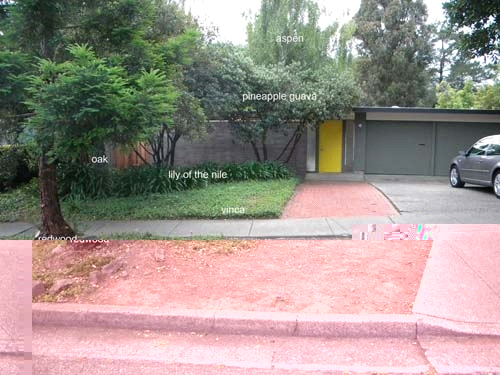
So, here's what I came up with...

OK, so how did I come up with this design? When I met the owners - a young couple - it was obvious that what they loved about the home was the Eichler design. So, first came the unspoken, but very present, thought : Respect the architecture. No problem. Second, what could the site do: as you can tell from the "before" picture, there was bare dirt from the curb to the sidewalk, which meant, "Without a sprinkler, here's what will grow here: a redwood (or other native) and an oak, another native." And then came the third criteria - the new owner's only real directive, "Make it easy to take care of, and look good." Both are busy, (probably) getting ready to start a family, and (definitely) want to invite friends and family to their new pad. They actually asked to keep the red brick walkway, mainly as a way to save money, but since this is just a design exercise, I went ahead and updated the walk too in the picture. There is a red brick patio in the courtyard that is going to be replaced (that will be the next blog) and I didn't want to have two different materials. A minimum of different materials is key to a clean, modern design.
Now for the fourth criteria, my own personal aesthetic. I like things to be clean, and simple, almost to a fault. Some people think it may be too starck. I just really like the simple lines of the house - to me, that is the strength of a Mid-century modern house like this. With this design, I wanted to show off the architecture and make the landscape part of the home's design.
Another major issue for me was that the house was hiding behind the landscape, and, since the front faces north, it seemed a little dark and not so inviting. That's one of the reasons I chose a light colored gravel - to make it brighter, and cleaner. The pavers continue the use of a lighter material, and they mimic a pattern of the long rectangular bricks found in the wall.
One thing you'll notice is a line of Japanese boxwood that runs parallel to the wall. This reinforces the lines of the architecture - especially the exposed beams - and actually hides a necessary french drain that needs to be installed in front of the wall. It also adds a green line, to keep the design from being to minimal. I like to call it the balance of white and green. The gravel - the white - and the white stone (or concrete) pavers add a fresh look, and much needed light to the front. The green adds an anchor, and the trees each have enough room to be sculptural elements. I hope you - and they - like it.
Next issue: The Eichler Courtyard.
Robert Leeper is a guest blogger on landscape design for Marin & San Francisco Modern. He is the founder of Robert Leeper Designs, a landscape design firm established in Austin Texas which recently expanded to Marin County, California. Contact Robert at 415-322-9254 or visit him online at Robert Leeper Designs.
Robert Leeper is a guest blogger on landscape design for Marin & San Francisco Modern. He is the founder of Robert Leeper Designs, a landscape design firm established in Austin Texas which recently expanded to Marin County, California. Contact Robert at 415-322-9254 or visit him online at Robert Leeper Designs.
Marin Modern - Heroes of Modern Landscapes
Posted by Robert Leeper on Saturday, June 12th, 2010 at 8:47am.
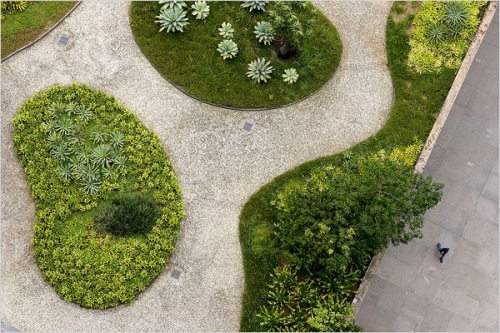
Robert Burle Marx holds a special place in the development of modernism in the field of landscape architecture. Often times in books - and in my professor's history courses - he was set apart from others of the same period. In Elizabeth Rogers' book, Landscape Design, she gives him his own sub-chapter: Roberto Burle Marx and the Garden as Abstract Art.
Wikipedia says:
"Roberto Burle Marx in Brazil combined the International Style and native Brazilian plants and culture for a new aesthetic. "
That sums it up nicely - a new aesthetic. He was - and still is - so unique, that he stands out as a iconic master in the profession. His works are iconic also, especially the famed Copacabana Beach in Rio de Janeiro.
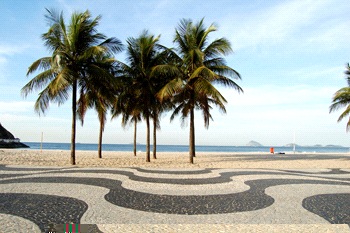
His paving patterns are often refered to as modernist painting. So it should come as no surprise that Burle Marx was also a painter. And a botanist and plant collector. And a musician/singer. And an early ecologist.
The fact that stands out about him - that speaks volumes to me - is that he is the sole landscape architect whose work has every beean featured in an exhibit at The Museum of Modern Art in New York City in 1991.
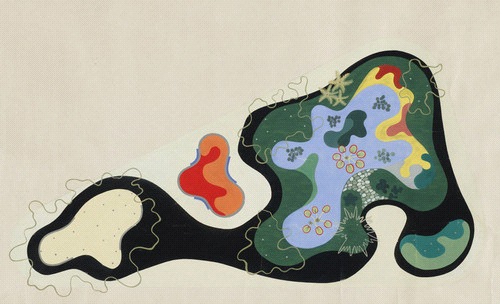 Here is one of his renderings for a landscape design. It's easy to see that he was an artist, whose medium was the landscape.
Here is one of his renderings for a landscape design. It's easy to see that he was an artist, whose medium was the landscape.Burle Marx is also very well-known for his collaborations with one of Brasil's best architects, Oscar Niemeyer, himself a hero of mid-century modern architecture.

In an article about another show of his work - this time at the Paco Imperial museum in NYC, last year - Larry Rohter writes:
At the peak of his career, Burle Marx was highly esteemed among his peers in the United States. In 1965 the American Institute of Architects awarded him its fine-arts prize, saying that he was “the real creator of the modern garden.”
His own home, which is now a museum, is his personal masterpiece. It isn't quite the modernist masterpiece one might expect. I think it clearly shows the full spectrum of his personality. It shows his love of architectural form, but is overwhelmingly a plant lover's garden. His collection of plants he found in the vast Brazilian jungles is one of the hallmarks of his legacy. He discovered, and named, many plants that were theretofore unknown. He was a passionate spokesperson for the environment, and made conservation a key part of his mission.
You can see more pictures of his home at this wonderful website.
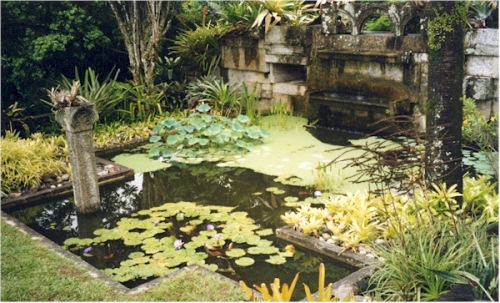
There's really nothing more that I can say. Except, "WOW!" Okay, there's one more thing I can say: I LOVE Roberto Burle Marx. He's my hero.
If you would like to take a phototour of his gardens, we are very lucky to have Mr. Malcolm Raggett's excellentphotojournal of most Roberto Burle Marx's gardens. Enjoy!
Next Blog Entry: A Case Study: A landscape for an Eichler home, right here in Marin County.
Robert Leeper is a guest blogger on landscape design for Marin & San Francisco Modern. He is the founder of Robert Leeper Designs, a landscape design firm established in Austin Texas which recently expanded to Marin County, California. Contact Robert at 415-322-9254 or visit him online at Robert Leeper Designs.
Robert Leeper is a guest blogger on landscape design for Marin & San Francisco Modern. He is the founder of Robert Leeper Designs, a landscape design firm established in Austin Texas which recently expanded to Marin County, California. Contact Robert at 415-322-9254 or visit him online at Robert Leeper Designs.
Marin Modern - Heroes of Modern Landscapes II
Posted by Robert Leeper on Monday, May 24th, 2010 at 8:46pm.
The first thing I thought about writing for this blog was a brief history of landscape design during the Mid-Century Modern period. Whenever I need to learn - or refresh my learning - about landscape design, I turn to Elizabeth Barlow Rogers' encyclopedic masterpiece, Landscape Design: A Cultural and Architectural History. If it isn't in there, it hasn't happened yet! And even though her website says it took her ten years to write, I secretly think it must have taken twenty - this book weighs a ton, and has over 500 pages of very dense text and hundreds of pictures. If you want to learn anything about landscape architecture, this is your textbook!
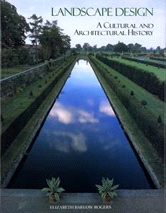
My other favorite resource is the remarkable Cultural Landscape Foundation whose mission is "dedicated to increasing the public's awareness of the important legacy of cultural landscapes and helping save them for the future." We are very fortunate to have a foundation that is dedicated to educating the public about important landscapes, and actually helps preserve them. Visit this site to learn, and please support their mission.
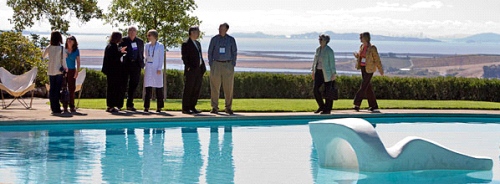
OK - on to Modernism! So, after a quick refresher course, here - in my own words - is what I relearned about the history of landscape design during the mid-century modern period:
There are many designers and writers who helped create the aesthetic of Mid-century Modernism. For this blog post, I am going to just talk about four in particular. They stand out as the best known names in Landscape Modernism: Garrett Eckbo, Dan Kiley, Thomas Church, and James Rose.
All of these designers were attracted to the new ideas about architecture that were the emerging during this period. They were articulate about their profession; they all wrote articles as well as practiced. Design was about ideas and ideals, about how the designed environment made a difference in people's lives, and were significantly more important than just aesthetics alone.
All previous "styles" were rejected as ornamentation. It could be argued that the previous styles were definitely the product of their time, with their own meanings - and not just set decoration. Modernism, however, sought to reduce the designed environment to it's minimally necessary elements, integrate interior and exterior spaces, and transform design from the past to the present. It was an evolution from - and some would say a rejection of - all that came before it. It wasn't this style or that style, it was the "un"-style, to borrow a line from 7-up's advertising.
These four designers took clues from the Bauhaus, Le Corbusier, and social thought of the day, and made a bold new statement about what a landscape could be. They integrated a new way of living - which is was what we now call creating outdoor rooms - into their designs. Aesthetically, they used plantings and materials to create spaces and gave the emerging profession of landscape architecture its cornerstone. Landscapes were not meant to dress up, ornament or embellish architecture; landscapes became architecture.
 Garret Eckbo was raised in the Bay area, and studied Landscape Architecture at UC Berkeley and later Harvard. He wrote a book in 1950 called Landscape for Living which addressed ideas of modernism in the landscape, especially how to make public housing more humane with thoughtful landscape design. He practiced primarily in California. He had many outstanding designs - including the Ocotillo Lounge in Palms Springs - but his greater contribution to the profession was his continuous writings about it. He wrote throughout his career, helping give definition to the emerging field of Landscape Architecture. He helped conect everyday people to the meaning, and practice, of landscape design.
Garret Eckbo was raised in the Bay area, and studied Landscape Architecture at UC Berkeley and later Harvard. He wrote a book in 1950 called Landscape for Living which addressed ideas of modernism in the landscape, especially how to make public housing more humane with thoughtful landscape design. He practiced primarily in California. He had many outstanding designs - including the Ocotillo Lounge in Palms Springs - but his greater contribution to the profession was his continuous writings about it. He wrote throughout his career, helping give definition to the emerging field of Landscape Architecture. He helped conect everyday people to the meaning, and practice, of landscape design. 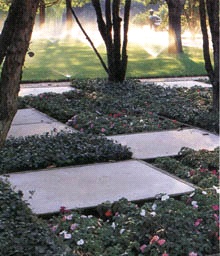 Dan Kiley was an interesting link between the past modernism. He utilized grid geometry in his designs that were similar to what Andre LeNotre did at Versailles for Louis XIV but without any ornamentation, nor any direct axis pointing to one person's power over a landscape. His designs look like circles on graph paper and are random squares, lines and orchard-like plantings of trees. This geometric layout - in real-time, on the ground, as experienced by you and I - was a clever way to create spaces, or rooms. There were hallways to walk through, orchards to meander in, and "living" rooms to relax and be with one another. His most famous mid-century modern residential landscape was The Miller Garden in Columbus, Indiana, with a house designed by Eero Saarinen.
Dan Kiley was an interesting link between the past modernism. He utilized grid geometry in his designs that were similar to what Andre LeNotre did at Versailles for Louis XIV but without any ornamentation, nor any direct axis pointing to one person's power over a landscape. His designs look like circles on graph paper and are random squares, lines and orchard-like plantings of trees. This geometric layout - in real-time, on the ground, as experienced by you and I - was a clever way to create spaces, or rooms. There were hallways to walk through, orchards to meander in, and "living" rooms to relax and be with one another. His most famous mid-century modern residential landscape was The Miller Garden in Columbus, Indiana, with a house designed by Eero Saarinen. Thomas Church wrote a book in 1955 called Gardens are for People where he dispensed practical advice on landscaping for homeowners, even those with modest homes. He went to school at Berkeley, and then Harvard, and returned to practice throughout California. His most seminal work is the Donnell Garden (pictured above), which is located in Sonoma. The website for The Cultural Landscape Foundation says the following about the design:
"At the Donnell garden, Church responded to the particular characteristics of site and client while exploring new forms. Of particular note was the biomorphic kidney-shaped pool; its Adaline Kent sculpture which functions both as a focal point and a tiny, inhabitable island; and the floating deck, designed with a checkerboard of wooden boards that preserved existing trees while extending the outdoor living space."
James Rose is the most unconventional of the group. While all were educated at Harvard's Graduate School of Design, and were friends - they were even called The Four Horsemen of Harvard - only Rose did not finish there. He was expelled! All of the modernists were interested in the revolutionary turns of architecture, landscape architecture and social issues, and they often co-wrote articles discussing these important developments. But he was expelled likely for his bucking the program being taught as too rooted in the past. Now that's what I call a commitment to one's beliefs. He was also different in his practice, doing mainly residential work, and being onsite as each was built, crafting instead of drafting, so to speak. This difference of made his work more personal, and he held tightly to his ideals. Ms. Rogers sums his philosophy up nicely:
"Like the architect Richard Neutra, Rose considered the separation between indoors and outdoors as a series of transparent planes, and his interlocking of exterior and interior forms promoted spatial fusion."
I like that word - fusion. It shows up on The Cultural Landscape Foundations' website when describing him also. We'll call James Rose the Fusionist. There is also a website devoted to him, called The James Rose Center.
Next Marin Modern blog post: Roberto Burle Marx, the only landscape designer to have a show featuring his work at The Museum of Modern Art, if you don't count the garden there, designed by Isamu Naguichi.
Robert Leeper is a guest blogger on landscape design for Marin & San Francisco Modern. He is the founder of Robert Leeper Designs, a landscape design firm established in Austin Texas which recently expanded to Marin County, California. Contact Robert at 415-322-9254 or visit him online at Robert Leeper Designs.
Robert Leeper is a guest blogger on landscape design for Marin & San Francisco Modern. He is the founder of Robert Leeper Designs, a landscape design firm established in Austin Texas which recently expanded to Marin County, California. Contact Robert at 415-322-9254 or visit him online at Robert Leeper Designs.






